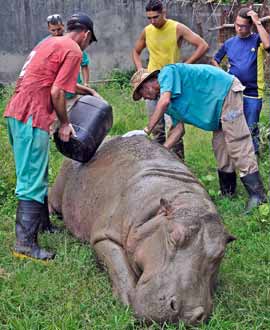Killing a Hippo: A Sad Incident in the Santiago de Cuba Zoo
Fabian Flores (Cafe Fuerte)

HAVANA TIMES — A strange and sad story has been circulating among animal lovers, Cuban environmentalists and the island’s limited blogosphere: a young hippopotamus that had escaped from a zoo in Santiago de Cuba has been shot to death.
The animal was shot down in the San Juan river area, near the Santiago de Cuba’s zoo, on June 27th. It had escaped from the facility and “had to be put down because of its shows of aggressiveness,” a local newspaper reported.
“The hippopotamus (…) became very aggressive and could have placed human lives at risk. There was no other alternative but to put it down,” the article stressed.
The three-year-old, 1.4-ton specimen had just been brought to the facility from the Pradera Africana pen in Havana’s Boyeros zoo at the request of the Santiago de Cuba park. Its relocation was divulged by Cuba’s official Granma newspaper in an extensive report titled Durmiendo hipopotamos (“Sedating Hippopotamuses”), which covered the first use of tranquilizer darts by Cuban animal experts.
Gunned Down
A day after the report was published the animal escaped and was subsequently killed. According to people closely involved in the incident, several 30-bullet cartridges of an AK-47 were emptied on the animal.
“At first, every operation to try and keep the animal live, including the mobilization of personnel recruited for such purposes, was set in motion,” reports Miguel Gainza Chacon.
The management of the Santiago de Cuba zoo then “confirmed the need to put an end to the animal’s life,” the article added.
However, an anonymous commentator at the Cuban blog En el Colimador (“Under the Lens”) thinks differently: “The options available were not exhausted. They indeed “put the hippopotamus to sleep, after they massacred it with several rounds of AK-47s.”
The incident has prompted harsh criticisms from journalists and bloggers in social networks. A source linked to the Santiago de Cuba zoo acknowledged that the facility has been showered with complaints over the incident and that the management has decided to thoroughly investigate the case.
Needless Killing
“I don’t understand what happened with the hippopotamus. We read the same, boring phrase that it had to be killed in three different paragraphs, and I still don’t understand why they had to. The story is so badly told that I can’t help think they simply butchered the animal. I’m willing to be persuaded otherwise, but I doubt anyone can,” teacher and journalist Milena Recio wrote on her Facebook page.
Sandra Alvarez, a psychologist, blogger and Global Voices web-site contributor, opined it is time to start demanding the closure of Cuban zoos.
“If they didn’t try and keep animals like museum pieces, they would never have had to put it down for its aggressiveness. It’s just shameful,” wrote Alvarez, author of the blog Negra Cubana Tenia que Ser.
Roberto Suarez, a participant in the Sierra Maestra on-line newspaper forum, expressed himself in more radical terms: “Those responsible should be brought to justice.”
Hippopotamuses in captivity normally live for anywhere between 25 and 30 years, much longer than they do in the wild.
Cast Away from the Herd
The gunned-down animal showed numerous scars and wounds on its skin, caused by the attacks male hippos suffer when they are driven away from a herd by other males.
Between 2012 and 2013, Cuba received 135 wild animals donated by Namibia, but no hippos were reported in the donated lots. The animals transported to Cuba in the two Noah’s Arc operations were destined to the Boyeros Zoo, which covers an area of 342 hectares in Havana.
The Namibian government declared the animals were donated to Cuba as a show of gratitude for the support the country offered them during their independence struggle against South African occupation in the 1970s and 1980s, stressing that their transportation met the norms of the Convention on the International Trade of Endangered Species.
On that occasion, the Namibian Society for the Prevention of Cruelty Against Animals (NSPCA) lamented that wild animals should be captured and condemned to captivity.
The most well known Cuban zoo, located in Havana’s neighborhood of Nuevo Vedado, is currently being refurbished.






I bet they love it!
If ther care of humans is not the best, I doubt the animals run with more luck!
We have the same problem in the rest of the nation, but not with animals with Young black kids.
Sickening tards are everywhere.
Actually, here in Vermont the same seems to be happening to our black bear population. As the 1% and their 5 to 8% acolytes encroach on prime bear habitat with their second- and thrid-vacation homes, they force the local game wardens to kill bears which have gotten into their garbage bins, or come up on their decks to gobble dog or cat food left out. There has been a holocaust of black bear deaths during the past decade.
The Israelis seem to have the same mantra for Gaza!
KILL KILL KILL seems to be Cuba’s mantra.
What a coincidence! Less than a day after the slaughter of this magnificent animal, more than a ton of an unnamed meat butchered into steaks and ground meat showed up in the black market around Santiago de Cuba.